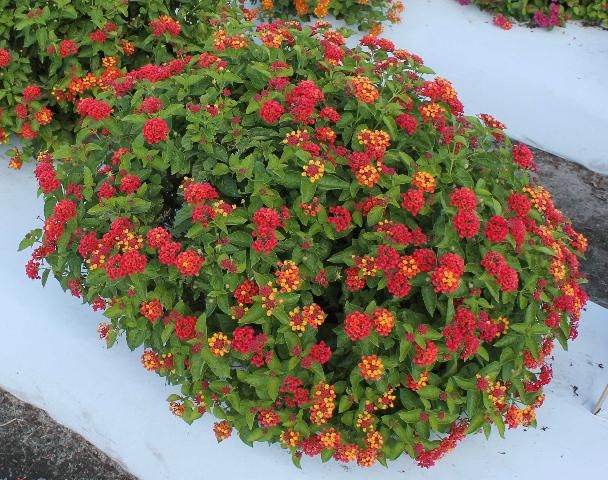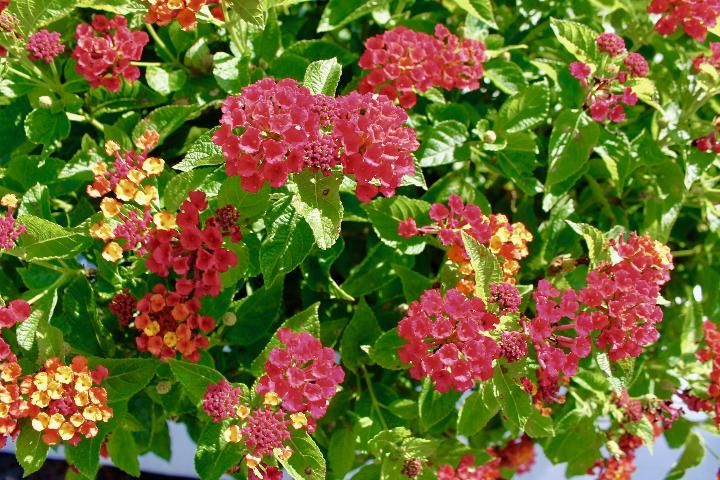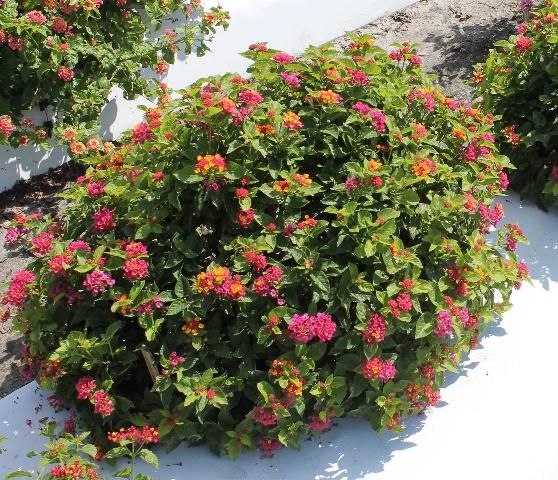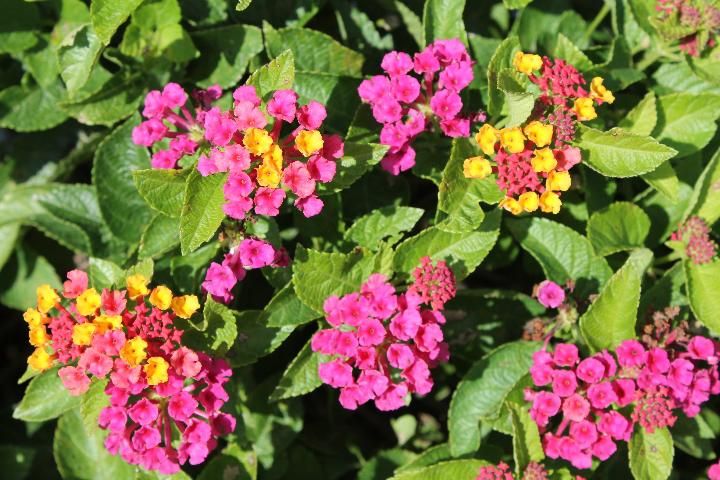Lantana camara is a popular nursery and landscape plant in the United States, particularly in Florida and other southern states. A 2003 survey of the Florida nursery industry indicated an estimated annual sales value of over $40 million for lantana commercially produced in Florida (Wirth et al. 2004). Lantana produces showy flowers year-round in most parts of Florida, attracts butterflies, tolerates droughts and salts, has low maintenance requirements, and is easy to propagate. These attributes make lantana highly desirable for use in containers, hanging baskets, and landscapes.
L. camara has been listed as a Category I invasive species in Florida because it can hybridize with Florida's native species Lantana depressa (Florida Exotic Pest Plant Council 2015). Based on evaluation of escaped and naturalized (resident type) plants, the UF/IFAS Assessment of Nonnative Plants in Florida's Natural Areas concluded that L. camara is invasive in south, central, and north Florida (https://assessment.ifas.ufl.edu/assessments/lantana-camara/) (UF/IFAS Assessment 2016).
A research program was initiated in 2004 at UF/IFAS's Gulf Coast Research and Education Center (GCREC) to develop infertile L. camara cultivars. The program released two highly infertile cultivars ('UF-T3' and 'UF-T4') in 2011 (Czarnecki et al. 2012). 'Bloomify Red' and 'Bloomify Rose' are new infertile L. camara cultivars that have been developed by this program. Both cultivars have been trialed and tested in Florida and reviewed by the IFAS Infraspecific Taxon Protocol (ITP) (Lieurance et al. 2016), which concluded that the two cultivars are "not a problem species." In 2016, the IFAS Cultivar Release Committee approved the release of the two cultivars (Deng et al. 2017). A plant patent application has been filed for each of the new cultivars under their code names 'UF-1013A-2A' and 'UF-1011-2'. The Florida Foundation Seed Producers, Inc. has awarded an exclusive license to Ball Horticultural Company for propagation and/or production. It is expected that 'Bloomify Red' and 'Bloomify Rose' will be commercially available beginning in fall 2017 or spring 2018.
Plant, Stem, Leaf, and Flower Characteristics
'Bloomify Red' plants are shrubs with a mounding growth habit (Figure 1) and are about 11 in wide and 10 in tall. Young stems are yellow-green, four-sided in cross section, semi-woody, and covered with soft hairs but no prickles; old stems are close to being round in cross section, light brown, smooth, and have few hairs. Leaves are opposite, simple, and yellow-green in color. Mature leaf blades are ovate, serrated (34–44 teeth), broadly truncated at the base, and acute at the apex. The upper leaf surface is green and covered with soft hairs, and the lower surface is also green. Inflorescences bear 28–30 flowers, are umbel-like, have a width of approximately 1½ in. across the top, and have yellow-green stalks called peduncles that are 1¾ to 2⅓ in long. Flowers are bright yellow when they first open and later turn red (Figure 2). Inflorescences rarely bear fruit (drupes). Flow cytometry results indicate that this cultivar is likely a triploid (Table 1).

Credit: UF/IFAS

Credit: UF/IFAS
'Bloomify Rose' plants are shrubs with a mounding growth habit, approximately 11 in wide and 9 in tall (Figure 3). New stems are yellow-green, four-sided in cross section, semi-woody, and covered with soft hairs; old stems are close to being round in cross section, light brown, smooth, and have few hairs. Leaves are opposite, simple, and yellow-green. Mature leaf blades are ovate with serrated margins (29–39 teeth), a broadly truncated base, and an acute apex. The upper leaf surface is green and covered with soft hairs, and the lower surface is also green. Inflorescences bear 26–30 flowers, are umbel-like and shaped like a flattened semi-sphere, have a width of approximately 1½ in across the top, and have yellow-green peduncles that are 1¾ to 2½ in long. Flowers are multicolored, opening initially as bright yellow-orange and then turning magenta (Figure 4). Inflorescences rarely bear fruit. Flow cytometry results indicate this plant is likely a triploid (Table 1).

Credit: UF/IFAS

Credit: UF/IFAS
Plant Height and Width
Plants of 'Bloomify Red' were significantly shorter and smaller than plants of 'Pink Caprice' (Table 2). By 2 months post-transplanting to ground beds, plants of 'Bloomify Red' were 29% to 36% shorter and 50% to 63% narrower than 'Pink Caprice'. By 5 months post-transplanting, plants of 'Bloomify Red' were 40% to 55% shorter and 57% to 65% narrower than 'Pink Caprice'.
Plants of 'Bloomify Rose' were also significantly shorter and smaller than plants of 'Pink Caprice' (Table 2). By 2 months post-transplanting, 'Bloomify Rose' plants were 40% to 51% shorter and 49% to 58% narrower than 'Pink Caprice' plants; by 5 months post-transplanting, 'Bloomify Rose' plants were 49% to 55% shorter and 59% to 66% narrower.
Male Fertility
Two pollen staining experiments were conducted using fresh anthers collected from field-grown plants. In Experiment 1, newly opened flowers were collected from plants grown at UF/IFAS GCREC in July 2015, while in Experiment 2, flowers were collected from plants grown at the Indian River Research and Education Center (IRREC) in August 2015. Anthers were extracted from the flowers and stained with fluorescein diacetate, and pollen grains were subsequently examined under a fluorescent microscope. Plump, round pollen grains fluorescing bright yellowish-green were considered viable, while misshaped, non-fluorescing, or unevenly, lightly fluorescing pollen grains were counted as non-viable. The average pollen stainability of 'Bloomify Red' and 'Bloomify Rose' was 3% and 9.7%, respectively, comparable to the pollen stainability of 'UF-T3' (Table 1). The average pollen stainability of fertile 'Pink Caprice' was 73.1% (Table 1).
Female Fertility
Previous studies have shown that fruit (seed) production per peduncle and seed germination/seedling emergence are the primary factors in determining lantana's female fertility. A female fertility index can be derived by multiplying fruit production per peduncle and seed germination (Czarnecki 2011; Czarnecki et al. 2012).
Two replicated field trials were conducted, one at UF/IFAS GCREC and the other at UF/IFAS IRREC, to determine the fruit production of 'Bloomify Red' and 'Bloomify Rose'. The experimental design used in both locations was a randomized complete block, with three blocks and two plants per plot at UF/IFAS GCREC, while four blocks and a single plant per plot were used at UF/IFAS IRREC. At each site, 'Pink Caprice' was included as a "resident species" taxon, and 'UF-T3' as a sterile check. Fruit production data were collected in four rounds of fruit harvesting between August and November 2015. In each round, 20 peduncles were randomly sampled from each plant and fruit on peduncles were counted.
Fruit Production per Peduncle
'Pink Caprice' produced the largest number of fruit in the two trials, with an average of 9.13 fruits per peduncle. 'UF-T3', 'Bloomify Red', and 'Bloomify Rose' averaged 0.04, 0.01, and 0.03 fruits per peduncle, respectively (Table 3).
Seed Germination
Mature fruit were collected from plants in the above described experiments. Air-dried seeds were germinated at UF/IFAS IRREC, and also tested at Midwest Seed Services in Brookings, SD for seed viability. 'Pink Caprice' seeds had an average of 65% viability and 45% germination (Table 3). For 'UF-T3', nine seeds were collected from the UF/IFAS GCREC and UF/IFAS IRREC trials, and only one seed germinated, resulting in 11.1% germination. 'Bloomify Red' did not produce mature seeds at either site, so no seed germination data are available for this cultivar (Table 3). For 'Bloomify Rose', four seeds were collected from plants at UF/IFAS GCREC and no seeds were collected at UF/IFAS IRREC, and none of these germinated (Table 3).
Female Fertility Index
The female fertility index for 'Pink Caprice' was 4.17, similar to previously reported values (Czarnecki et al. 2014). For 'UF-T3' and 'Bloomify Rose', the female fertility index was 0.005 and 0, respectively (Table 3). Due to the lack of seed germination, it was not possible to calculate the female fertility index for 'Bloomify Red'. Based on its triploidy and extremely low fruit production, it is expected that its female fertility index would be similar to that of 'Bloomify Rose' and close to 0.
Hybridization Potential with Lantana depressa
In 2015, hand pollinations were performed in a greenhouse at GCREC to assess the hybridization potential of 'Bloomify Red' and 'Bloomify Rose' with L. depressa. 'Pink Caprice' and 'UF-T3' were included in the pollination experiments as fertile and infertile controls. Fresh anthers were collected from mature, unopened flowers of male parents and applied immediately to emasculated flowers of female parents. At maturity, fruit produced by pollinated flowers was collected and counted, and seeds were extracted and germinated.
When 'Pink Caprice' was used as a male parent, it produced an average of 8.6% fruit set on L. depressa (Table 4). The reciprocal cross resulted in 19.7% fruit set. Seeds from crosses between 'Pink Caprice' and L. depressa had 11.1% germination, and the reciprocal cross had 15.8% germination. Meanwhile, 'UF-T3' flowers pollinated with L. depressa produced 0.8% fruit set and none of the seeds germinated. When 'Bloomify Rose' was used as a male on L. depressa, it produced an average of 0.2% fruit set (Table 4). The fruit contained one seed, and it failed to germinate. The reciprocal cross did not set fruit. Crosses between 'Bloomify Red' and L. depressa in either direction did not produce fruit. (Table 4).
Propagation and Container Plant Production
Cuttings of 'Bloomify Red' and 'Bloomify Rose' rooted well following standard propagation procedures under greenhouse conditions. Rooted cuttings produced flowering potted plants within 4 to 6 weeks, depending on the temperature in the greenhouse and pot size.
UF/IFAS Assessment
The Infraspecific Taxon Protocol is an internal tool developed by UF/IFAS to evaluate cultivars (and varieties, hybrids, or subspecies) of resident nonnative invasive species in order to give a recommendation of their use in Florida (Lieurance et al. 2016). In July 2016, pollen stainability, fruit production, and seed viability/germination data of 'Bloomify Red' and 'Bloomify Rose' and their hybridization potential with L. depressa were presented to the UF/IFAS Assessment staff as formal ITP requests. It was concluded that 'Bloomify Red' and 'Bloomify Rose' are not likely to be problem species (https://assessment.ifas.ufl.edu/assessments/lantana-camara-bloomify-red/; https://assessment.ifas.ufl.edu/assessments/lantana-camara-bloomify-rose/) and can be recommended for commercial production and landscape use in Florida.
Conclusion
Compared to 'Pink Caprice', a L. camara cultivar that is close to the species' resident taxon (escaped and naturalized form), the pollen stainability and fruit production of 'Bloomify Red' and 'Bloomify Rose' were reduced by about 85% and 99%, respectively. These two new cultivars did not produce viable seeds, and they did not lead to fruit set when used as male parents in hand pollinations with L. depressa. These high levels of male and female infertility were stable at GCREC and IRREC. These results indicate that 'Bloomify Red' and 'Bloomify Rose' have little potential to hybridize with L. depressa. 'Bloomify Red' and 'Bloomify Rose' have good branching, a mounding growth habit, and bright flower colors. They are expected to be desirable replacements for existing fertile L. camara cultivars.
Availability
US plant patent applications have been filed for 'Bloomify Red' and 'Bloomify Rose'. License agreements for propagation and production of these two lantana cultivars are managed by Florida Foundation Seed Producers (FFSP), Inc. (http://www.ffsp.net), a non-profit, direct support organization of the University of Florida. FFSP used its Invitation to Negotiate (http://www.ffsp.net/itn/) process to solicit proposals from companies interested in an exclusive license for these lantana cultivars. Subsequently, FFSP awarded an exclusive propagation and production license to Ball Horticultural Company to market them under its Bloomify brand.
References
Czarnecki II, D.M. 2011. Genetic sterilization and reproductive biology of Lantana camara. PhD Diss. University of Florida.
Czarnecki II, D.M., A. Hershberger, C.D. Robacker, and Z. Deng. 2014. "Ploidy level and pollen stainability of Lantana camara cultivars and breeding lines." HortScience. 49:1271–1276.
Czarnecki II, D.M., S.B. Wilson, G.W. Knox, R. Freyre, and Z. Deng. 2012. "UF-T3 and UF-T4 – Two sterile Lantana camara cultivars." HortScience. 47:132–137.
Deng, Z., S.B. Wilson, X. Ying, and D.M. Czarnecki. 2017. "UF-1011-2 and UF-1013A-2A Infertile Lantana camara cultivars." HortScience. 54(2): 652–657.
Florida Exotic Pest Plant Council (FLEPPC). 2015. 2015 List of Invasive Plant Species.http://fleppc.org/. Accessed 8/21/2016.
Lieurance, D., S.L. Flory, and D.R. Gordon. 2016. The UF/IFAS Assessment of Nonnative Plants in Florida's Natural Areas: History, Purpose, and Use. https://edis.ifas.ufl.edu/pdffiles/AG/AG37600.pdf. Accessed 1/25/17.
University of Florida Institute of Food and Agricultural Sciences Assessment of Nonnative Plants in Florida's Natural Areas (UF/IFAS Assessment). 2016. Lantana camara. http://assessment.ifas.ufl.edu/assessments/lantana-camara/. Accessed 1/25/17.
Wirth, F.F., K.J. Davis, and S.B. Wilson. 2004. "Florida nursery sales and economic impacts of 14 potentially invasive ornamental plant species." J. Environ. Hort. 22:12–16.
Nuclear DNA content, likely ploidy level, and pollen stainability of 'Bloomify Red', 'Bloomify Rose', and two checks, 'UF-T3' and 'Pink Caprice', grown in Balm and Ft. Pierce, FL, in full sun (2015).
Plant height and width of 'Bloomify Red', 'Bloomify Rose', 'UF-T3' (infertile check), and 'Pink Caprice' (fertile check), grown at the UF/IFAS Gulf Coast Research and Education Center (GCREC) in Balm, FL, or at the Indian River Research and Education Center in Ft. Pierce, FL, in ground beds in full sun in 2015 (2 and 5 months post-transplanting).